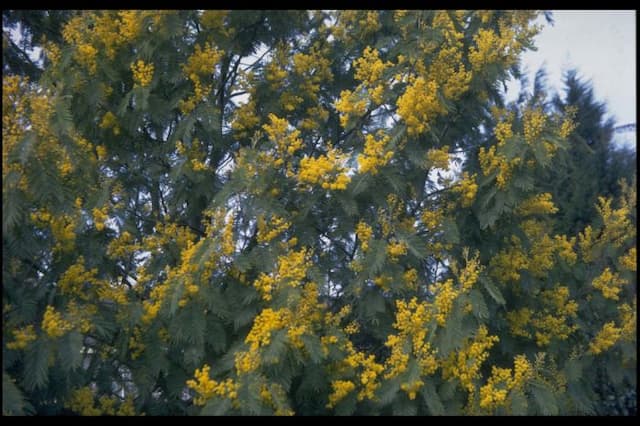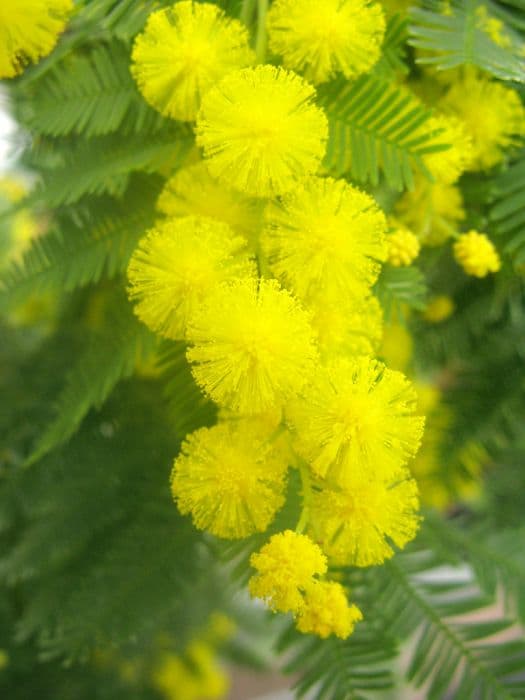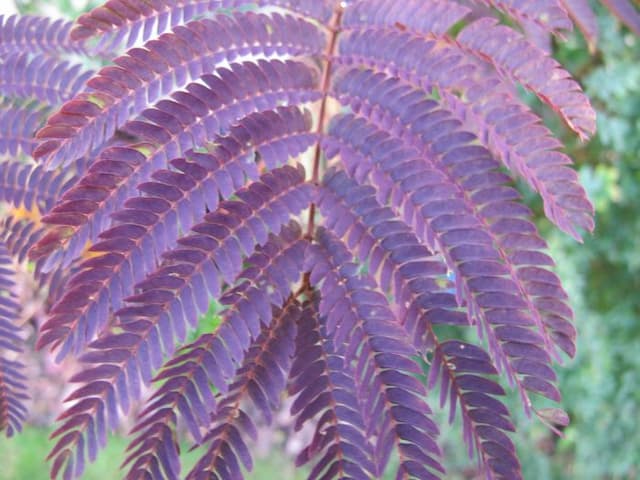Lupine Lupinus 'Manhattan Lights' (PBR)

ABOUT
Lupinus 'Manhattan Lights' is a striking perennial, known commonly as a hybrid lupine. Its distinctive appearance comes from the bicolored flower spikes that boast a beautiful mix of purples and yellows. The flowers are densely packed on a tall, erect stem, which emerges from a base of palmately compound leaves. These leaves are made up of several leaflets that radiate out from a central point, giving them a hand-like appearance, characteristic of the lupine family. The blooms of 'Manhattan Lights' are known for their brightness and showiness, providing a strong visual impact in garden settings. Each individual flower on the spike exhibits a harmonious blend of deep purples and soft yellows, often with purple edging or magenta tones alongside the vibrant yellow. This contrast makes the flowers stand out and contributes to the plant's popularity amongst gardeners looking for eye-catching displays. The foliage of the 'Manhattan Lights' lupine is also noteworthy, with a rich green color and a slightly hairy texture. The leaves are thoughtfully arranged in a circle around the stem, lending an organized, lush appearance to the plant even when not in bloom. Overall, the 'Manhattan Lights' lupine is known for these visually delightful flowers and attractive foliage, making it a favorite in ornamental gardens for its color and form.
About this plant
 Names
NamesSynonyms
Manhattan Lights Lupine, Manhattan Lights Lupin
Common names
Lupinus 'Manhattan Lights' (PBR)
 Toxicity
ToxicityTo humans
Lupins, including the variety 'Manhattan Lights,' contain alkaloids that can be toxic to humans. If ingested, parts of the plant, particularly the seeds, can cause symptoms such as nausea, vomiting, abdominal pain, and dizziness. In severe cases, the toxicity can lead to respiratory depression and convulsions. It is advised to refrain from eating any parts of the lupin plant and to seek medical attention if ingestion occurs.
To pets
Lupins, including the variety 'Manhattan Lights,' contain alkaloids that can be toxic to pets like dogs and cats. If a pet ingests parts of the lupin plant, they can experience symptoms of toxicity which may include lethargy, loss of appetite, vomiting, diarrhea, and in severe cases, may progress to tremors or seizures. Immediate veterinary care should be sought if a pet consumes any part of a lupin plant.
 Characteristics
CharacteristicsLife cycle
Perennials
Foliage type
Deciduous
Color of leaves
Green
Flower color
Mixed
Height
3 feet (91 cm)
Spread
2 feet (61 cm)
Plant type
Herb
Hardiness zones
4
Native area
North America
Benefits
 General Benefits
General Benefits- Ornamental Appeal: Offers striking bicoloured blooms in shades of yellow and purple, enhancing the visual attractiveness of gardens and landscapes.
- Attracts Pollinators: Serves as a magnet for bees, butterflies, and other beneficial pollinators, supporting biodiversity.
- Fixes Nitrogen: As a member of the legume family, it enriches soil by fixing nitrogen, thus improving soil fertility.
- Easy to Grow: Known for its hardiness and low maintenance requirements, making it suitable for novice gardeners.
- Tolerates Poor Soil: Can thrive in less fertile soils, reducing the need for soil amendments and fertilizers.
- Seasonal Interest: Provides vibrant color in late spring to early summer when many other plants are not in peak bloom.
- Versatility in Landscaping: Can be used in a variety of garden settings, including borders, mass plantings, and as a backdrop for other plants.
- Drought Resistance: Once established, it has good drought tolerance, making it suitable for xeriscaping and arid environments.
 Medical Properties
Medical PropertiesThis plant is not used for medical purposes.
 Air-purifying Qualities
Air-purifying QualitiesThis plant is not specifically known for air purifying qualities.
 Other Uses
Other Uses- Lupine seed pods can be used in dried flower arrangements once the seeds are removed, providing an interesting texture and shape to the composition.
- The fibers from lupine stems can be explored for textile use in creating specialty papers or crafts, similar to the use of flax fibers.
- Lupine seeds, when properly treated to remove toxins, can be used as a high-protein ingredient in animal feed for livestock.
- The plants can be used in phytoremediation to help restore nitrogen to depleted soils in gardens or farms as they are nitrogen-fixing.
- Lupines can play a role in companion planting, supporting and enhancing the growth of crops such as cucumbers by deterring pests.
- The colorful lupine flowers are attractive to photographers and painters, often serving as a vibrant subject for visual art projects.
- Used in educational settings, lupines can serve as a study subject for botany students learning about plant structure and pollination.
- The tall and striking flower spikes of lupines can be used as natural stakes or supports for climbing plants in the garden.
- Lupine roots can help stabilize soil and combat erosion on slopes or in areas where ground cover is needed.
- When used in larger landscape designs, lupines can provide a dramatic visual backdrop for weddings and outdoor events.
Interesting Facts
 Feng Shui
Feng ShuiThe Lupine is not used in Feng Shui practice.
 Zodiac Sign Compitability
Zodiac Sign CompitabilityThe Lupine is not used in astrology practice.
 Plant Symbolism
Plant Symbolism- Innovation and Creativity: Lupinus 'Manhattan Lights', also known as Lupine, features a striking blend of yellow and purple spikes that can be symbolic of breaking traditional boundaries and embracing creative solutions.
- Diversity and Inclusion: The variety of colors represented in its flowers can serve to represent the beauty of diversity and the importance of including all different voices and perspectives.
- Transformation: Lupine in general may signify transformation and metamorphosis, as it grows from a simple seed into a tall, vibrant flowering plant.
- Resilience: Lupine is known for its ability to thrive in poor soil conditions, symbolizing the ability to persist and flourish even in hard times or adversity.
 Water
WaterThe Manhattan Lights lupine should be watered deeply once a week, ensuring that the soil is moist but not waterlogged. During hotter, dryer periods, increase watering to twice a week. Provide about one gallon of water per plant per watering session, adjusting for rainfall. In winter or during periods of heavy rainfall, reduce watering to prevent soil from becoming soggy. Always water at the base of the plant to avoid wetting the foliage, which can lead to fungal diseases.
 Light
LightThe Manhattan Lights lupine thrives in full sunlight to partial shade, but it produces the most abundant blooms when exposed to full sun for at least six hours a day. Choose a location that provides bright, direct light in the morning with some afternoon shade in hotter climates to prevent scorching.
 Temperature
TemperatureThe Manhattan Lights lupine prefers a temperate climate with temperatures ranging from 60 to 75 degrees Fahrenheit during the growing season. It can survive minimum temperatures down to around 25 degrees Fahrenheit, but it may not survive prolonged periods of extreme cold. Optimal growing conditions are achieved within this temperature range.
 Pruning
PruningDeadhead spent Manhattan Lights lupine blooms to encourage further flowering and to maintain a tidy appearance. Prune back the foliage in late fall or early winter after it has died back. This annual pruning helps to prevent disease and prepares the plant for the next growing season.
 Cleaning
CleaningAs needed
 Soil
SoilThe Lupine 'Manhattan Lights' prefers well-draining soil enriched with organic matter. A soil mix with equal parts of loam, peat, and sand works best, and the pH should ideally be slightly acidic to neutral, between 6.0 and 7.0.
 Repotting
RepottingLupine 'Manhattan Lights' typically does not require frequent repotting as it is a perennial plant. It should be repotted every 2-3 years or when it outgrows its current container.
 Humidity & Misting
Humidity & MistingLupine 'Manhattan Lights' thrives in average humidity conditions that replicate its natural outdoor environment, without the need for any special humidity adjustments.
 Suitable locations
Suitable locationsIndoor
Ensure bright light, avoid over-watering, and maintain cool temperatures.
Outdoor
Plant in sun, well-draining soil, with space for growth.
Hardiness zone
4-8 USDA
 Life cycle
Life cycleThe life cycle of the Lupinus 'Manhattan Lights', also known as Lupine, begins with seed germination, typically in early spring when soil temperatures warm. Seedlings emerge and establish a rosette of palmate leaves before developing a strong taproot. As the plant matures, it sends up a flowering stalk that can reach up to 3 feet tall, adorned with bi-colored purple and yellow spikes, usually blooming from late spring to early summer. After pollination, typically by bees, the flowers form pods that contain the seeds which, when mature, will burst open to disperse seeds for the next generation. The lupine plant is a perennial and, once established, will enter a period of dormancy in the winter, with the foliage dying back and the plant surviving via its root system. The plant re-emerges in the following spring, continuing its cycle of growth, flowering, and seed production.
 Propogation
PropogationPropogation time
Spring-Early Summer
Lupinus 'Manhattan Lights', commonly known as Lupine, can be propagated through seed. The most popular method is sowing the seeds in spring directly into the soil or starting them indoors in pots before the last frost. To ensure optimal germination, it's recommended to soak the seeds in water for 24 hours prior to sowing. Once soaked, plant the seeds about ¼ inch deep (approximately 6 millimeters), and keep the soil lightly moist until germination, which typically takes 14-28 days. After seedlings have developed true leaves and there's no risk of frost, they can be transplanted outdoors to their final growing location, making sure they're spaced about 18 inches (approximately 45 centimeters) apart to allow for their mature size.









